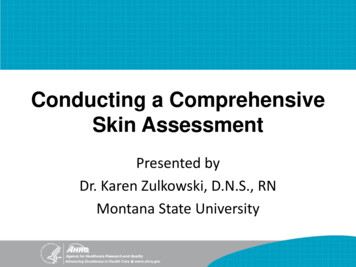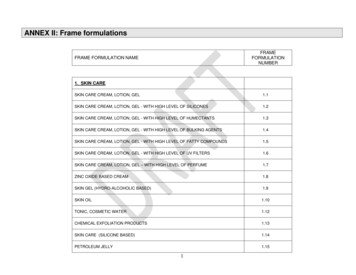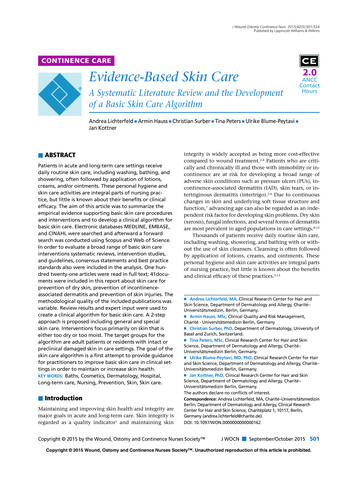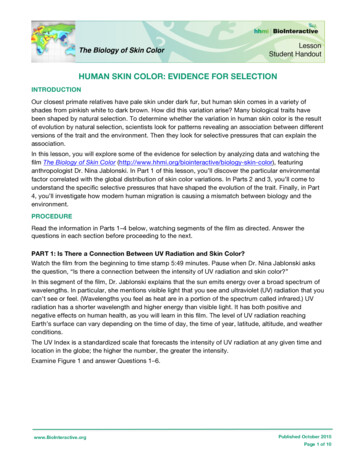
Transcription
June-July2004 - 01604Terry Hutchens Extension Associate for Goat Production UK & KSUDr. Monty Chappell, Extension Small Ruminant Specialist UKDr. Marion Simon, State Extension Specialist for Small Farm &Part-time Farmers KSU“Enough to Make Your Skin Crawl”Goat Skin DiseaseBacterial Skin Diseases of the GoatTerry Hutchens Extension Associate, UKand KSUThe wet weather continues, andmany Kentucky goats are showing signs ofskin disease. There are volumes of skindisease information therefore, we have triedto narrow the scope and describe the mostcommon diseases being diagnosed byKentucky veterinarians.The skin disease most commonlyseen in late winter and early spring is calledDermatophilosis, caused by the bacteriaDermatophilus congolensis. During dryweather, the organism may survive in soilor on goat hair. Any kind of injury thatbreaks the skin surface or causes damageto the epidermis such as external parasites,shearing or feed bunk irritation, allows theorganism to penetrate and establish withinthe skin of the goat.As would be expected, the bacteriumremains inactive until the onset of rainyweather, humid weather conditions.Therefore, for Kentucky, the active seasonbegins in March and perhaps ends as lateas July.Signs of the disease in the adultanimal can be seen on the feet, nose,muzzle and scrotum. Kids are most ofteninfected in the ear area. Lesions begin asraised scabs, and these infection sites maybecome covered with matted hair. DryChorioptic mange mitecrusts, scaling and hair loss characterizehealing lesions or chronicly infected lesions.Secondary infections may also occur, suchas the foot scald bacteria, Fusobacteriumnecrophorum, causing pain and itching oninfected sites.Diagnosis of the disease is by skinbiopsy and smears from most activelesions.Treatment and Prevention:1. Avoid housing in wet, muddycrowded conditions.2. Construct a number of three sidedrain shelters rather than dependenceon one housing site such as a barn.Movable shelters are ideal for smallfarms.3. Gutter barns and provide welldrained lots.
4. Provide standing baths, deepenough to contact the infected areasof adult goats. Treat with iodinecompounds or 2 to 5% lime sulfur,once a week for 4 weeks.5. Where practical, groom infectedgoats with a brush to remove scabs.Disinfect the brush between eachanimal.6. Control external parasites.7. For animals with extreme conditions,treat with penicillin-streptomycin, ortetracycline. Contact yourveterinarian for details.the mite with severe cases occurring in thewinter.Infestation signs are the formation ofraised pustules on the skin, crusting, hairloss, reddening of the skin and eventuallyulceration. These signs are first seen on thelower limbs, scrotum, udder and betweenthe thighs. Rubbing and scratching iscommon.Treatment and Prevention:1. Avoid housing in wet, muddycrowded conditions.2. Construct a number of three sidedrain shelters rather than to dependonly on one site such as a barn.Movable shelters are ideal for smallfarms.3. Collect and burn all bedding4. Store hay separate from goathousing site5. Remove animals from the housingsite and disinfect the housing6. All goats must be treated at thesame time and treatment regimentmust be followed7. Treatments: See Table 1A second possible skin diseaseis Staphylococcal Dermatitis.Staphylococcal skin infections are commonin goats and are the result of infection andinflammation of hair follicles. The mainlesions are pustules. These pustules oftendischarge exudates and become encrusted.Common features of the chronic or healingstage of the disease are hair loss andscaling. Many small pustules may appearon the teats, udder, perineum (inner thighs),and the under side of the tail.Table 1Lime sulfurIn extreme cases, the infection becomesgeneralized resulting in infection of the skinof the abdomen, inner thighs, the back andneck areas. Localized lesions on the uddercan be washed with chlorhexidine or aniodine based shampoo. Dry the area withindividual paper towels and treat with anantibiotic ointment. Animals need to betreated for 1 to 2 weeks. Check with yourveterinarian for specific antibiotic needs.Antibiotic sensitivity tests are often onand othersamitrazMitaban,Preventic,Taktic andotherslindaneMange MitesChorioptic Mange: This mite lives on thesurface of the skin of the goat. Someanimals may be carriers of the mite with outshowing signs of infestation. These mitescan live in barns and pens for up to 10weeks. However, cold temperatures favor4 times atweeklyintervals2 times at10 -14 dayintervals2 times at10 -14 dayintervals2.0 – 5.0%dip2 times at10 -14 dayintervals.025% .05% spray.25% spray.50% dust.20 spraysand dips2 times at.06% 10 -14 dayspraysintervals.03% dip1. Read and follow all label directionsand restriction.2. Consult with your local veterinarian2
something indescribable or impossible tobring into the framework of volume, weightor area. I can relate to this when speakingin terms of billions of dollars or light yearsaway.However, if given time and practice,the use of dry matter oriented pasturemanagement may very well be one of thebest tool in the old-mental-tool box. First,we need to define dry matter. Dry matter isthe percentage of plant sample, whichremains after all the water, has beenremoved from the sample.Why are we concerned about removingall the water from a plant sample? Theanswer is, because it is difficult to describea quantity of plant material or percent plantnutrient within a plant when plant waterlevels constantly change. Plant water levelsare highest in wet conditions and lowest indry or saline conditions. Water contentvaries from spring to summer to fall andpresents a formidable challenge whentrying to recommend numbers of goats tothe acre, or describe the percent of proteincontent in alfalfa hay. Dry matter just givesa baseline for describing weight, volume,area and content of the forage.regarding product and treatment.3. *Note: Chorioptic mites may betoo superficial, that is, they do notfeed deep within the skin of theanimal and therefore ivermectinmy not be an effect treatment.Sarcoptic Mange: This disease is causedby a mite that tunnels through the skin. Ifthe disease is diagnosed, it must bereported to government authorities. Severalweeks after infection, goats develop smallitchy nodules, typically on the head. Insome goats, the disease may progress nofurther, however in others, extensive skinthickening and hair loss occurs because ofscratching and mite damage. In addition,the infestation may affect the head, neck,thorax, inner thighs and udder area. Asecondary bacterial infection may developand in rare cases result in death.Subcutaneous ivermectin injections maybe very effective in controlling this disease.Contact your local veterinarian forassistance in diagnosis and treatment.Note: Subcutaneous injections of ivermectinhave little or no effect on internal gastrointestinal -------------Source: M.C. Smith, D. M. Sherman, 1994,Goat medicine, ISBN 0-8121-1478-7S. Mitcham, A. Mitcham, 2000, Meat goat,their history, management and diseases,ISBN 0-9664476-2-XUse of Dry Matter Measurements toDetermine Stocking RatesHow many times have you ask yourself, how many goats should I put on this 5acre field? In answering this question, youneed to know, how much dry matter is inthe field and how much dry matter the goatswill consume each day. All these questionscan be answered when forage weight,volume and consumption rates areconverted to dry matter.Field Assessment Method1. What is the average weight of thegoats grazing the 5-acre field? Howmany goats are you going to graze?Example: 25 does at 125 lbs each2. How much dry matter will a goat eatper day? We generally allow 3.5 to5.0% of live body weight for drymatter needs.“Dry Matter”What it is, and how to use itThe word dry matter seems to turnmany people off. I have actually seen this inpractice. When speaking to farmers aboutforages and grazing goats, all I need to sayis the brain-deadly word, “dry matter”, andthe crowd’s attention is forever lost. It is myfeeling that the term dry matter brings tomind something not very pleasant. Perhapsfarmers have the understanding that drymatter means something dry and dusty andsticks in your throat or clogs up your lungs.On the other hand, it may bring to mind3
matter on the pasture.Therefore, a residualgrazing height must be set.In this case, we havechosen to graze off 50% ofthe forage or graze down to6 inches and move thegoats. So (2375 lbs * .50%) 1188 lbs availableforage/acre. So (1188 lbs ofavailable forage/156 lbs ofdry matter need each day) 8 days of grazing for eachacre.5. How much should I let the pastureregrow before returning to graze apasture? Figure 1 illustrates thisconcept of grazing management verynicely. This figure shows that intakeand digestibility decline with maturityof the pasture plants. However, drymatter production per acre increaseswith maturity. With these twoopposing factors in mind, the solutionis to make a compromise on quality,(intake and digestibility) and yield.The compromise is somewherebetween boot stage of the grass andbud stage of the legume (seecrossing of the lines of the graph)and beginning head formation and fullbud. A second and third compromisecan be made for lactating andgrowing kids. Theseanimals shouldgraze to the left sideof the graphjuncture whilemature dry pregnantdoes can maintainwell on the rightside of the juncture.a. Example: 25 does x 125 lbs 3125 lbs of body weight.3125 lbs x .05 percent ofbody weight 156 lbs of drymatter needed each day.3. How much dry matter is in the 5-acrefield? Take a standard yardstick ormeter stick, walk through the 5-acrefield, and measure the height of theforage standing in the field. Do notpull or extend the tip of the blade forthe measurement, or measure seedheads, but simply set the stick on theground and read the measurementfrom the top-most dense area of thepasture. Check the height at 10 ormore locations. The greater thenumber of samples, the greater theaccuracy of your dry matter estimate.a. Example: The averageheight of the tall fescueclover pasture was found tobe 12.5 inches. Using thetable on page 6, (12.5inches X 190 lbs drymatter/inch of pastureheight/acre) 2375 lbs drymatter per acre.4. How many days of grazing can I safelygain from 2375 lbs of dry matter/acrebeing grazed by 25 does?a. Example: Goats cannotgraze 100% of the dryFigure 1.4
Field Dry Matter Evaluation FormDetermine the areaof the fieldClipboard CopyTerry Hutchens, Extension Associate UK/KSUSteps the length and width of Length X 3 ft Width X 3 ft the field. Make steps threefeet long and record incolumns to the eHeight4SampleHeight5SampleHeight6Sample Sample Sample SampleHeight Height Height t15---------SampleHeight16---------- ---------- ---------- ---------Sample Sample Sample SampleHeight Height Height lAverage GrandheightHeightheightHeight AveragefromfromHeightfromfromsamples samples samples samples1-101-1011-2011-20/ 10/ 10-------------------AHow many grazingdays are availablein this -------------------- ---------What is thepredominantforage type?--------------------Lengthin ftXWidthin ft ----------CAverage HeightXD(Lbs/acre inch)Value of forage type fromtable on back side ---------CXD ( lbs of dry matter/acre)A -Number of Animals X Average Wt. X 0.05% Live ----------------------------------------------- Grazing Days/Acre.50------------------ (50%)--------------------% ResidualXlbs Dry Matter/Acre5
Dry Matter EstimatesIn pounds/inch of pasture height/acre3Average1SpeciesRange2Alfalfa/Alfalfa and Grass22575-400Bermudagrass260150-500Caucasian bluestem18075-350Kentucky bluegrass160100-175Native warm season10050-250Orchardgrass18075-300Orchardgrass and clover200100-325Red Clover220100-300Annual Ryegrass25075-400Oats, rye, wheat (annual15075-250Tall Fescue210100-350Tall Fescue and clover19080-325grassescereals)1The values should only be used as a guide. These estimates assume thick, well-fertilized, actively growing stands.2Range covers thin, non-fertilized, often unmanaged stands to the high end, whichrepresents thick stands with rapid growth and high yields.3Source: D. M. Ball, C.S. Hoveland, and G. D. Lacefield, 2000:Forage Crop PocketGuide, Item # 32-0001, Reference # 200646
2002 Census of Agriculture is outThe 2002 meat goat inventory, accordingto the 20002 Census of Agriculture is 61618head of goats found on 2979 farmers inKentucky. If you compare the 2002 numberto the 1997 inventory of 13037 head on1712 farms, there is a 79% increase ininventory since the last census. This is animpressive increase however; my personalfeeling is that we were much larger thanthis number. For 2002, Kentucky wasassisted as being third in the nation innumbers of goats marketed 42,923 and fifthin inventor. However, a 2003 marketpotential study assisted Kentucky to bethird in the nation in goat numbers that mayapproach 100,000 head.Terry HutchensExtension Associate Specialist for GoatProductionAnimal Sciences615 W.P. Garrigus BuildingLexington KY, 40546-1027University of Kentucky /Kentucky State UniversityPhone 859-257-2465Fax iculture/AnimalSciences/goat/goats.html7
Cooperative ExtensionServiceUniversity of Kentucky(Your) DepartmentAg Distribution Center229 Stadium View RoadLexington KY 40546-0229PRESORTEDSTANDARDUS POSTAGE PAIDLEXINGTON KYPERMIT #1098
become covered with matted hair. Dry crusts, scaling and hair loss characterize healing lesions or chronicly infected lesions. Secondary infections may also occur, such as the foot scald bacteria, Fusobacterium necrophorum, causing pain and itching on infected sites. Diagnosis of the disease is by skin biopsy and smears from most active lesions.











